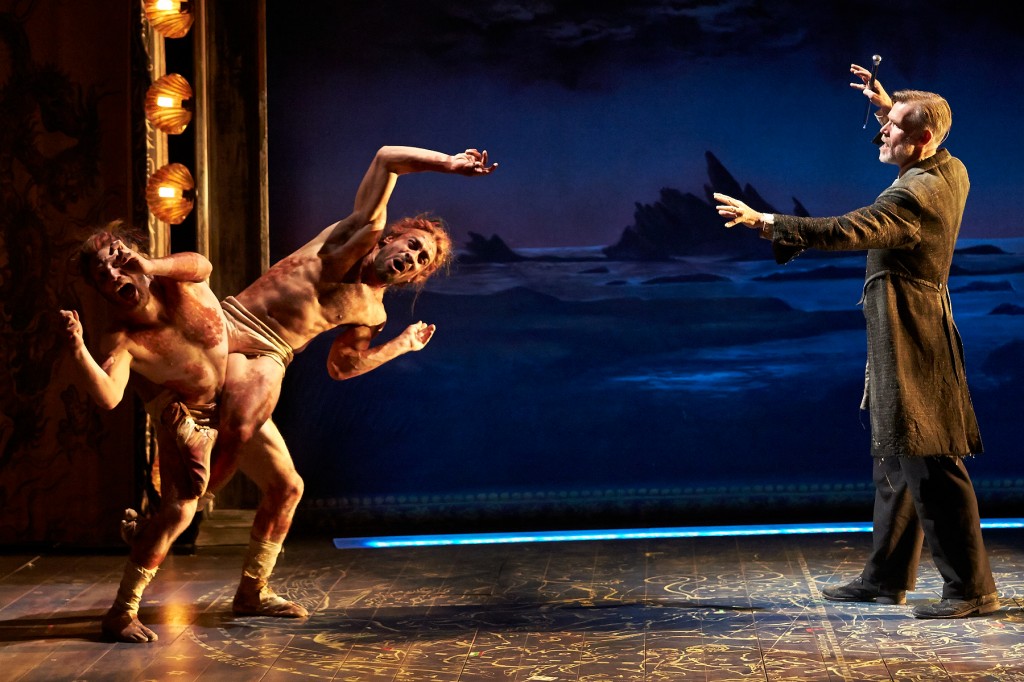 Full disclosure: I am not a Tempest fan. One of Shakespeare’s last plays, The Tempest is heralded as a farewell to the stage, a commentary on art and life, and a post-colonial exploration (though this last lens may be a later addition to the play’s analyses). The American Repertory Theater, in association with The Smith Center for the Performing Arts, present The Tempest in all of its spectacle and glory, and probably like nothing that you have seen onstage, let alone for a Shakespearean play. With fresh perspective and adaptation by Aaron Posner (famous for his directing as well as his playwriting—see Stupid F***ing Bird) and Teller (of the famous Comedy Central duo, Penn & Teller), the play is revived with the perfect amount of magic, excitement, and wonder to bring the 400-year-old play to the twenty-first century audiences. I couldn’t help wishing for something more from the famed A.R.T. that brought us the Broadway-running Pippin and Glass Menagerie, and I wonder if, behind the curtains and magic tricks, if we just see the smoke and mirrors, and wonder, “Doesn’t the Man Behind the Curtain have anything to say?”
Full disclosure: I am not a Tempest fan. One of Shakespeare’s last plays, The Tempest is heralded as a farewell to the stage, a commentary on art and life, and a post-colonial exploration (though this last lens may be a later addition to the play’s analyses). The American Repertory Theater, in association with The Smith Center for the Performing Arts, present The Tempest in all of its spectacle and glory, and probably like nothing that you have seen onstage, let alone for a Shakespearean play. With fresh perspective and adaptation by Aaron Posner (famous for his directing as well as his playwriting—see Stupid F***ing Bird) and Teller (of the famous Comedy Central duo, Penn & Teller), the play is revived with the perfect amount of magic, excitement, and wonder to bring the 400-year-old play to the twenty-first century audiences. I couldn’t help wishing for something more from the famed A.R.T. that brought us the Broadway-running Pippin and Glass Menagerie, and I wonder if, behind the curtains and magic tricks, if we just see the smoke and mirrors, and wonder, “Doesn’t the Man Behind the Curtain have anything to say?”
The Tempest centers on the former duke-of-Milan-turned-sorcerer/magician Prospero (Tom Nelis), a man who was too busy exploring and enjoying his books to notice that his brother Antonio usurped his kingdom, and, together with his daughter Miranda (Charlotte Graham), Prospero is banished out to sea. Our story starts when Prospero, hidden on an island with his magic books, and lord over the earthly and rustic Caliban (Zachary Eisenstate and Manelich Minniefee) and spiritual Ariel (Nate Dendy), casts his own tempest of a spell over the waters to shipwreck his deceitful brother Antonio (Louis Butelli); Gonzala, a noblewoman of Naples (Dawn Didawick); Alonso, the King of Naples (Christopher Donahue); Ferdinand, the Prince of Naples and Alonso’s son (Joby Earle); Sebastian, Alonso’s brother (Edmund Lewis); and Sebastian and Trinculo, musicians in Alonso’s court (Eric Hissom and Jonathan M. Kim, respectively).
Not bad for a small spell. Once the newcomers are separated and arrive on the island, Prospero has enough magic up his sleeve to terrorize his wrongdoers (and delight the audience). Unexpectedly (or not because it’s Shakespeare), Miranda and Ferdinand meet and instantly fall in love (though I doubt their history as a couple since Miranda has only known two men—her overbearing and protective father Prospero and the smelly and potential rapist Caliban). Meanwhile, Caliban, Sebastian, and Trinculo, drunk as they are dumb, conspire to kill Prospero, while Antonio and Sebastian conspire to kill Alonso, so that Sebastian can be King. Ultimately, with the help of some introspection and redemption (and lots of Ariel’s delightful magic), Prospero prevents the murder of Alonso, Ariel thwarts Caliban’s tyrannous plans, and Prospero forgives his wrongdoers. With a flourish, Prospero sets his guests free and plans for their travels back to Naples and Milan, and, in the ending moments, Prospero chooses to forego his magic with the audience’s help.
Not a bad set-up for a romantic play on what it means to be a good ruler, plots of intrigue and assassins, and the power of redemption and forgiveness over the power of control and domination. Part of the joy of any Shakespearean play is the transcendental power of the play’s themes to bridge time, place, and culture. And this is perfect for the A.R.T. to cast its magic spell over the audience. Starting with a lackluster and not very exciting opening (honestly, who makes the “tempest” the least interesting part of the entire play?), the play dazzles with its innovative approach to the magical island and to Prospero’s powers through his delightful sidekick Ariel. Dendy’s card tricks as the subservient but always interesting Ariel always dazzle, and they provide exactly the kind of innovation to keep some of Ariel and Prospero’s longer monologues sharp and interesting for the dull twenty-first century audience. I don’t want to diminish the A.R.T.’s audience, but I also know that most of Shakespeare’s work is lost on my generation. In their own way, the A.R.T. through Posner and Teller keep the play and its work timely and alive. I suppose that I should be thankful.
Nelis is a formidable Prospero, though a bit lackluster; I’m not sure where he misses the mark for me, but perhaps he feels that his work is done through spectacle and not through Shakespeare’s magical words. Despite these hesitations and perhaps limitations, his Prospero’s final moments are truly a delight and made the work come alive for me. For the first time, I enjoyed Prospero’s decision to give up his magic. The choice to give up had such a magical and redemption quality for him. I don’t want to give away how he chooses to give up his magic, but, while not a creative choice, it’s magical for me. One of the highlights for the show is the production’s creative choice for Caliban. Using the acrobatic and physical work of Eisenstat (gosh, that guy is versatile) and Minniefee, the Caliban is rustic, visceral and compelling to watch. The horror and fear of seeing this two-headed, four-armed monster bark out his aggression is staggering. The harmony of hearing both voices speak simultaneously is haunting and compelling; bravo to these two actors for their dedicated performance to bring this monster to life in a new and exciting way while creating a humanistic character worthy of our empathy and fear.
While I can’t say that I enjoyed the nobleman, I appreciated their command of Shakespeare’s language, especially Didawick as Gonzala; she knew her way around Shakespeare’s voice and it spoke volumes through her performance. It was nice to see that Shakespeare’s voice was not entirely lost in this production focused on the visual spectacle and technical prowess of the A.R.T. And that brings me to the young lovers. I don’t enjoy their story, one of the weakest and most contrived of Shakespearean lovers. I think their story speaks to more about Prospero’s views than on anything that they might say to each other, but, alas, we must endure their drivel. For what it’s worth, other people adored Earle’s Ferdinand, reminding many people of Arrested Development’s Buster. I found him a hammy caricature of a man with no agency, growth, or compelling characteristics; he did keep the action and emotion lively in what are otherwise dull scenes. Of course, perhaps Earle had to compensate for the stick-figure portrayal of Miranda by Graham. Graham feels out-matched on the A.R.T.’s stage; she can’t keep up with the skill of Nelis, Earle, or Dendy, and she struggles to stay afloat aboard the whirling storm of the Shakespearean language. Her performance is, indeed, a struggle of epic proportions to endure.
Thankfully, Posner and Teller keep the production moving at an alarming and breakneck pace. I don’t think that I’ve ever seen Shakespeare done so effectively. With the help of a very lively and evocative spirit band (kudos to their female singers for their powerful jams), the play shifts seamlessly from scene to scene, setting the stage for the next magical act (no pun intended). The set is a multi-tiered ship serves as a playground for Ariel and company to transition and travel, artfully designed by Daniel Conway, and his team of associate and assistant set designers Andrew Cohen, and Paige Hathaway and Joshua Madsen, respectively. While I felt many of the costumes left something to be desired, I appreciated their evocative touches, clearly delineating the classes of stories to be portrayed. The real wonder for me was the highly effective lighting design by Christopher Akerlind, which, with flashes and colors, told palettes of stories with their touches and influence.
As I reflect on the performance, I can’t help but smile by the awe and inspiration in seeing a play that I thought that I knew become transformed through the power of magical storytelling. For many, this performance will be their first introduction to The Tempest, and perhaps to Shakespeare in general. It is not a bad introduction. However, I wish that The Tempest had more behind its magic. After the smoke had settled, all I saw was the mirrors, the curtains, and the flashes of light. Shakespeare’s words were lost and the themes which resonate upon reading the play (or the substantial scholarly discourse) are pushed aside by the directors and company. For a play loaded with thematic resonance for a twenty-first century audience which encounters dictators, political upheaval, and colonial influence, I would expect more from the A.R.T. in pushing art beyond the visual and into our hearts. It takes a lot to call out one of the most formidable and impressive theatre companies in Boston, but I feel like there are stories left untold and the magic is hidden in The Tempest behind a curtain. Therefore, I ask: “Prospero (and A.R.T.), what magic do you keep hidden, and why did you deprive the Boston audiences of all of Shakespeare’s goodness for the sake of spectacle?” Ultimately, your story is a master of disguise rather than art.

